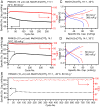Highly reversible Zn metal anode enabled by sustainable hydroxyl chemistry
- PMID: 35675422
- PMCID: PMC9214537
- DOI: 10.1073/pnas.2121138119
Highly reversible Zn metal anode enabled by sustainable hydroxyl chemistry
Abstract
Rechargeable Zn metal batteries (RZMBs) may provide a more sustainable and lower-cost alternative to established battery technologies in meeting energy storage applications of the future. However, the most promising electrolytes for RZMBs are generally aqueous and require high concentrations of salt(s) to bring efficiencies toward commercially viable levels and mitigate water-originated parasitic reactions including hydrogen evolution and corrosion. Electrolytes based on nonaqueous solvents are promising for avoiding these issues, but full cell performance demonstrations with solvents other than water have been very limited. To address these challenges, we investigated MeOH as an alternative electrolyte solvent. These MeOH-based electrolytes exhibited exceptional Zn reversibility over a wide temperature range, with a Coulombic efficiency > 99.5% at 50% Zn utilization without cell short-circuit behavior for > 1,800 h. More important, this remarkable performance translates well to Zn || metal-free organic cathode full cells, supporting < 6% capacity decay after > 800 cycles at -40 °C.
Keywords: Zn metal batteries; high reversibility; solid electrolyte interphase; sustainable electrolyte design.
Conflict of interest statement
Competing interest statement: The authors have a patent (US patent provisional application number 17528719) related to the electrolytes described in this article.
Figures




References
-
- US Geological Survey, Mineral commodity summaries 2021. https://pubs.er.usgs.gov/publication/mcs2021. Accessed 16 May 2022.
-
- Yaroshevsky A. A., Abundances of chemical elements in the Earth’s crust. Geochem. Int. 44, 48–55 (2006).
-
- Winter M., Barnett B., Xu K., Before Li ion batteries. Chem. Rev. 118, 11433–11456 (2018). - PubMed
-
- Blanc L. E., Kundu D., Nazar L. F., Scientific challenges for the implementation of Zn-ion batteries. Joule 4, 771–799 (2020).
-
- Liang Y., Dong H., Aurbach D., Yao Y., Current status and future directions of multivalent metal-ion batteries. Nat. Energy 5, 646–656 (2020).
LinkOut - more resources
Full Text Sources

